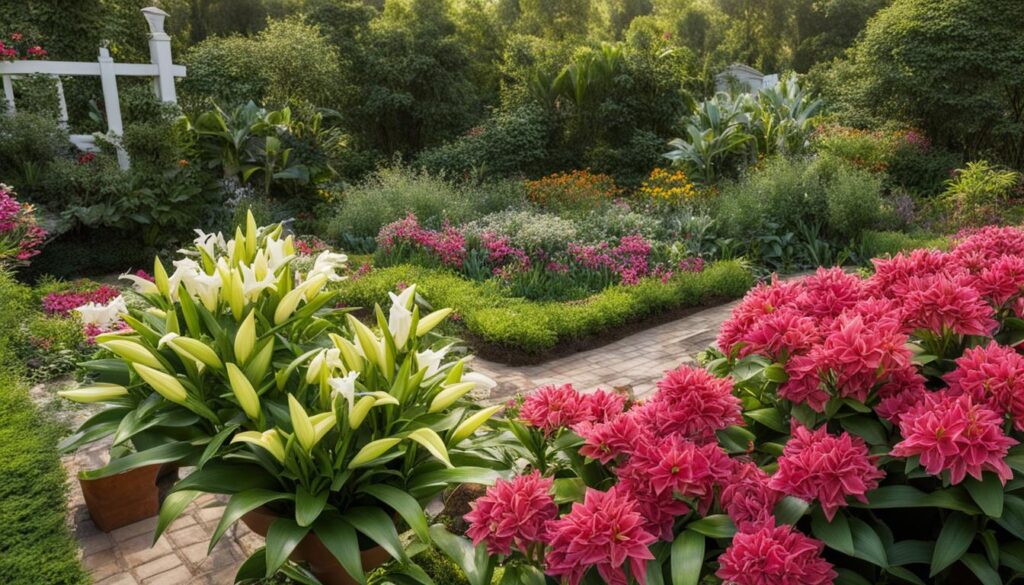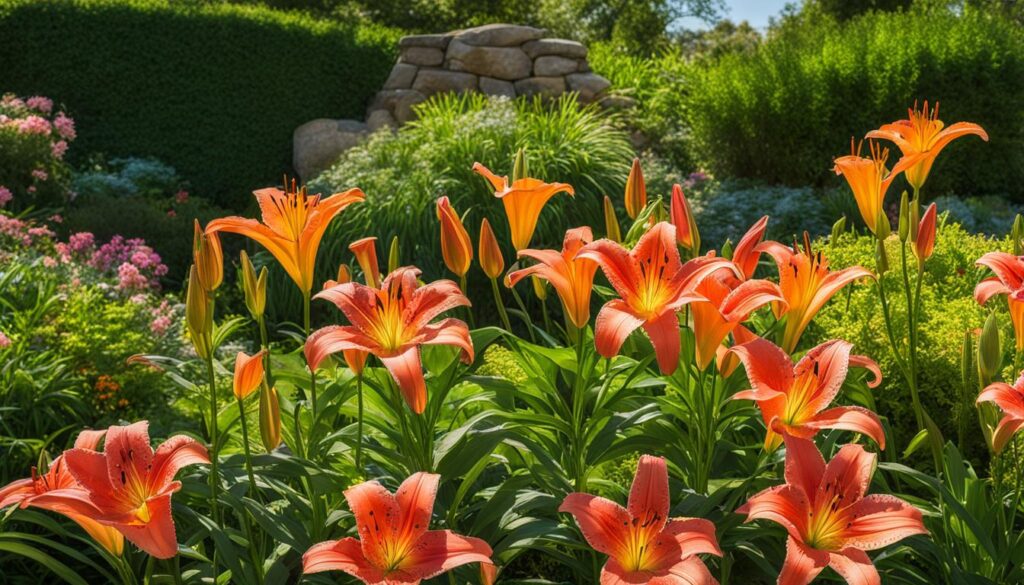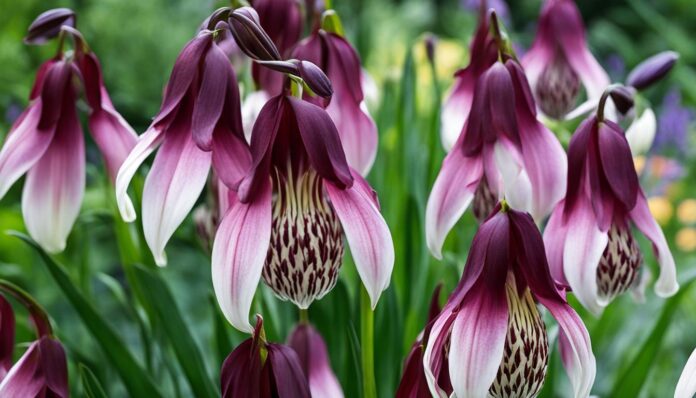As a professional gardener, I am always on the lookout for unique and exotic additions to enhance the beauty of my garden. That’s when I discovered the Persian Lily, scientifically known as Fritillaria persica. These little-known perennials have captured my heart with their stunning blooms and eye-catching foliage. Let me share with you why Persian lilies are a must-have for any garden enthusiast.
Persian lilies have been around since 1573, but surprisingly, they are not widely planted in gardens across the United States. These native flowers of Middle Eastern countries stand out with their distinctive blue-gray foliage, which adds an element of sophistication to any garden landscape. Not only are they visually striking, but they are also resistant to rabbits and deer, making them a practical choice for those dealing with garden pests.
When it comes to growing Persian lilies, they prefer well-draining soil and thrive in full sun to part shade. Planting the bulbs in the fall, about 5 to 7 inches deep, ensures a spectacular display of their dark plum, bell-shaped blooms in the following spring. They can be planted en masse to create a dramatic effect or paired with tulips for a stunning color combination. Furthermore, the flowers make excellent additions to cut arrangements, allowing you to bring a touch of exotic appeal indoors.
Key Takeaways:
- Persian lilies, or Fritillaria persica, are a unique and exotic addition to any garden.
- Their blue-gray foliage adds an element of sophistication, and they are resistant to rabbits and deer.
- Persian lilies thrive in well-draining soil and prefer full sun to part shade.
- These spring-blooming bulbs produce stunning dark plum, bell-shaped blooms.
- Persian lilies can be planted en masse or paired with tulips for a captivating display.
Persian Lily Care
When caring for Persian lilies, it’s important to provide them with the right conditions to thrive. Here are some key tips for Persian lily care:
Planting Persian Lilies
Persian lilies are spring blooming bulbs that should be planted in the fall before the ground freezes. Dig a hole that is approximately 5 to 7 inches deep and place the bulbs inside, with the pointed ends facing up. Make sure to plant them in well-draining soil to prevent rotting. Persian lilies prefer a spot with full sun to part shade, so choose a location that provides the right amount of sunlight for optimal growth.
Soil Requirements
Persian lilies thrive in well-draining soil. Avoid planting them in overly wet and soggy conditions, as this can lead to root rot. They can tolerate a wide range of soil types, but it’s best to provide them with a deep, organically rich soil that retains moisture without becoming waterlogged.
Rabbit and Deer Resistance
One of the advantages of growing Persian lilies is their resistance to rabbits and deer. The blue-gray foliage of Persian lilies is unappetizing to these animals, making them a great choice for gardeners dealing with pest issues. Enjoy your Persian lilies without worrying about them being eaten by furry visitors.
Growing Conditions
Persian lilies are hardy in zones 4 to 8 and can withstand various growing conditions. They provide vertical interest in the spring garden with their dark plum, bell-shaped blooms. Persian lilies can be grown en masse to create a dramatic effect or incorporated into mixed borders for a stunning display. They also pair well with other spring-blooming bulbs like tulips.
“Persian lilies are a low-maintenance choice for gardeners, thanks to their resistance to rabbits and deer and their ability to tolerate a wide range of soil types. With proper care, they will reward you with beautiful blooms that add a touch of exotic appeal to your garden.”

Benefits of Growing Persian Lily
There are several benefits to incorporating Persian lilies into your garden. These vibrant spring flowers offer a stunning display that can enhance the visual appeal of any outdoor space. With their vibrant colors and unique bell-shaped blooms, Persian lilies add a touch of exotic beauty to garden borders and floral arrangements.
Persian lilies are not only visually striking but also pollinator-friendly. Their tall stems, reaching up to 3 feet in height, produce clusters of dozens of flowers that attract pollinators like butterflies. By planting Persian lilies in your garden, you create a welcoming habitat for these essential creatures, contributing to the overall health of your local ecosystem.
Another advantage of Persian lilies is their versatility as an excellent cut flower. The long stems and vibrant blooms make them perfect for creating stunning bouquets and floral arrangements. Whether you’re preparing a centerpiece for a special occasion or simply adding a pop of color to your home, Persian lilies are a fantastic choice.
One of the added benefits of growing Persian lilies is their low-maintenance nature. These perennials are relatively easy to care for, making them suitable for both experienced and novice gardeners. While they require well-drained soil and prefer full sun to part shade, Persian lilies do not demand excessive attention. However, it is important to be aware of potential damage from slugs and snails, as these pests may target the foliage.
To demonstrate the advantages of growing Persian lilies, here is a table summarizing their main benefits:
| Benefits of Persian Lily |
|---|
| Vibrant spring flowers |
| Pollinator-friendly |
| Excellent cut flower |
| Low-maintenance perennial |
Overall, Persian lilies offer a myriad of benefits for gardeners. From their vibrant spring blooms to their pollinator-friendly nature, these flowers are a fantastic addition to any garden. Whether you’re looking to create a vibrant color display or attract butterflies to your backyard, Persian lilies are sure to impress.
Garden Locations and Cultivation of Persian Lily
Persian lilies, also known as Fritillaria persica, can thrive in a variety of garden locations and cultivation settings. These stunning spring blooming bulbs are commonly grown in sunny borders, rock gardens, and naturalized areas, adding beauty and charm to any landscape.
When selecting the right spot for planting Persian lilies, it’s crucial to consider their preference for well-drained soils. These bulbs thrive in deep, organically rich, and medium moisture soils that allow for proper drainage. A sunny border, where the bulbs can bask in full sun, is an ideal location for Persian lilies. However, in hot summer areas, providing some light afternoon shade can be beneficial to prevent scorching.

“Persian lilies can be grown in sunny borders, rock gardens, and naturalized areas.”
When planting Persian lilies, ensure they are positioned 6 inches deep in the soil and spaced 9 to 12 inches apart. This spacing allows each bulb to receive adequate nutrients and growth space. To improve drainage, adding sand or grit to the planting hole can be beneficial.
In colder regions, winter mulching is recommended to protect the bulbs and ensure their successful emergence in the following spring. Persian lilies have the potential to naturalize and spread in the garden over time, creating an enchanting display of their elegant blooms.
| Garden Locations | Cultivation Tips |
|---|---|
| Sunny Borders | Choose a spot with full sun and well-drained soil. |
| Rock Gardens | Plant in areas with good drainage and ample sunlight. |
| Naturalized Areas | Allow Persian lilies to spread naturally in open spaces. |
By cultivating Persian lilies in your garden, you will be rewarded with their striking beauty and captivating presence. These unique and exotic flowers are sure to become a highlight of any landscape, providing a touch of elegance and charm.
Conclusion
Persian lilies, also known as Fritillaria persica, are a unique and exotic addition to any garden. These spring blooming bulbs offer a stunning display with their tall stems and dark plum, bell-shaped blooms. They have a unique charm that sets them apart from other flowers, with their mesmerizing blue-gray foliage and resistance to rabbits and deer.
With proper care, Persian lilies can thrive in a variety of garden locations, making them a versatile choice for any garden design. Whether planted in sunny borders, rock gardens, or naturalized areas, they add an unforgettable touch of exotic appeal. Their low-maintenance nature makes them even more desirable, and they can make excellent cut flowers for creating gorgeous bouquets and floral arrangements.
If you’re looking to elevate the beauty of your garden with a stunning display, consider incorporating Persian lilies. Their unique charm and exotic appeal will captivate all who lay eyes on them. So why wait? Start cultivating Persian lilies in your garden today and enjoy the breathtaking beauty they bring to your outdoor space.
FAQ
What is a Persian Lily?
Persian lilies, scientifically known as Fritillaria persica, are a little-known perennial that offers numerous benefits for gardeners. They are spring blooming bulbs with tall flowers that serve as a show-stopping focal point in garden borders.
Where are Persian lilies native to?
Persian lilies are native to Middle Eastern countries.
What color are Persian lilies?
Persian lilies produce dark plum, bell-shaped blooms in a range of colors, from deep purple to cream.
When should Persian lily bulbs be planted?
Persian lily bulbs should be planted in the fall before the ground freezes, approximately 5 to 7 inches deep.
Do Persian lilies attract pollinators?
Yes, Persian lilies attract pollinators like butterflies.
Can Persian lilies be grown in pots?
While Persian lilies prefer to be planted in the ground, they can be grown in pots as long as they have sufficient drainage.
Are Persian lilies deer-resistant?
Yes, Persian lilies have blue-gray foliage that is resistant to rabbits and deer.
How tall do Persian lilies grow?
Persian lilies can grow up to 3 feet in height.
Can I use Persian lilies as cut flowers?
Yes, Persian lilies make excellent cut flowers and can add drama to bouquets and floral arrangements.
What are the best companion plants for Persian lilies?
Persian lilies can be paired with yellow and white tulips for a beautiful color display.

